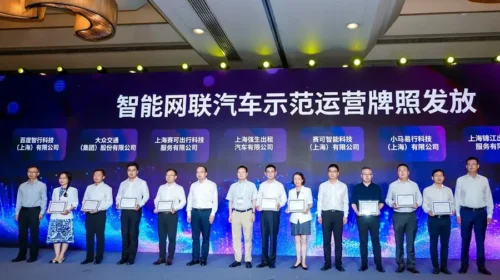Robotaxi rollout drives faster earnings pace at WeRide

The driverless technology company is enjoying a payoff from expanding its global taxi fleet, with quarterly revenues surging and losses continuing to shrink
Key Takeaways:
- Third-quarter revenue more than doubled, marking the biggest quarterly jump in the company’s history
- Gross margin leapt to 32.9% as robotaxi revenues took off
By Lee Shih Ta
Driverless car company WeRide Inc. (0800.HK; WRD.US) has accelerated along the path towards profitability, powered by surging robotaxi revenues.
Competitors in the robotaxi race are vying to scale up their global fleets and motor into new cities to grab market share and break free from a loss-making cycle.
With its driverless taxis now taking to the roads in Abu Dhabi and other cities around the world, WeRide more than doubled the turnover figures in its latest quarterly earnings, staunching some of the red ink on its bottom line and moving a meaningful distance towards the elusive break-even point.
Delivering its first results since listing in Hong Kong earlier this month, WeRide reported that its third-quarter revenues jumped 144% to 171 million yuan ($24 million) from the year-earlier period, swelled by a growing international fleet of autonomous vehicles. Robotaxi revenues rocketed up 761% to 35.3 million yuan, going from 5.8% to 20.7% of total turnover.
Gross margin spurt
The company’s net loss for the three months to end-September shrank by almost a third to 307 million yuan from 1.04 billion yuan in the same period a year earlier, although the adjusted loss edged up to 276 million yuan from 240 million yuan. Meanwhile, gross margin jumped 26.4 percentage points to an industry standout level of 32.9%.
Losses narrowed for the third straight quarter, an uncommon feat for a company that is investing heavily to test and roll out driverless automotive technology.
For the first nine months of the year, the robotaxi operator’s revenue rose 68.2% to 371 million yuan, while its net loss shrank to just under 1.10 billion yuan from 1.92 billion yuan in the same period of 2024.
By contrast, its arch competitor Pony.ai (PONY.US; 2026.HK) posted a smaller revenue jump and presided over a worsening loss. Its third-quarter revenues rose 72% to $25.4 million while gross margin improved by 9.2 percentage points to 18.4% and its net loss widened 46% to $61.6 million.
In fact, both Pony.ai and WeRide are generating losses that far exceed their revenue, as the industry burns through cash in a battle for market share. Yet WeRide’s leap in gross margin could put it in pole position to achieve profitability down the road.
The critical success factor could be the company’s push into multiple markets for fully driverless, commercially viable operations, rather than relying on fleet expansion or subsidies to generate growth.
Middle East expansion
WeRide made a breakthrough this year by gaining landmark approval for fully driverless taxis in Abu Dhabi. It was the first city-level permit for autonomous robotaxis to be issued outside the United States, granted through what is regarded as a stringent regulatory process. WeRide’s robotaxis are allowed to operate for extended hours and across districts without in-vehicle safety officers, enabling the fleet’s finances to break even for the first time.
WeRide operates more than 150 autonomous vehicles in the Middle East and is aiming to expand its regional fleet into the tens of thousands by 2030. In Abu Dhabi, the company’s taxis cover roughly 50% of the city’s urban core. The commercial permit is helping to drive cost efficiencies, boosting gross margin.
Progress has also been made in Europe. In November, WeRide was granted a robotaxi permit to operate in the Swiss Canton of Zurich, with services expected to launch in 2026. Securing a foothold in Switzerland, with its exacting approval system, offers a credible endorsement in the eyes of the global market.
As of October, WeRide operated more than 1,600 autonomous vehicles overall, including nearly 750 robotaxis. With the Swiss permit, its vehicles are now licensed to operate in eight countries.
WeRide is doubling down on technology, earmarking some of the proceeds of its Hong Kong listing for this purpose. It has already partnered with Bosch to develop an advanced driver-assistance system that has been adopted by major Chinese automakers and is approaching mass production. The one-stage end-to-end L2+ system is an enhanced form of semi-automation in which the vehicle can initiate certain actions and maneuvers.
The company announced this month that it had started manufacturing an end-to-end L2+ solution incorporating more advanced L4 technologies. This marks the first time WeRide has applied the architecture beyond robotaxis, opening a potential pathway for advanced self-driving features to flow into consumer passenger models.
On the first trading day after the earnings, WeRide’s U.S.-listed shares jumped 14.7% to close at $8.26, though they remain down about 40% in the year to date. Its Hong Kong-listed shares rose a more moderate 1.75% to HK$20.88, still about 16.4% below the listing price. Despite its overseas progress, WeRide trades at a price-to-sales ratio of roughly 35.9 times using Hong Kong metrics, lower than Pony.ai’s 46.8 times.
Although investors remain sensitive to risks in the self-driving sector, WeRide has shown that it can turn a localized profit in some jurisdictions. If it can demonstrate stable earnings from high-barrier markets such as Abu Dhabi and Switzerland, and sales of its L2+ product line take off, it could see its valuation perk up.
To subscribe to Bamboo Works weekly free newsletter, click here






